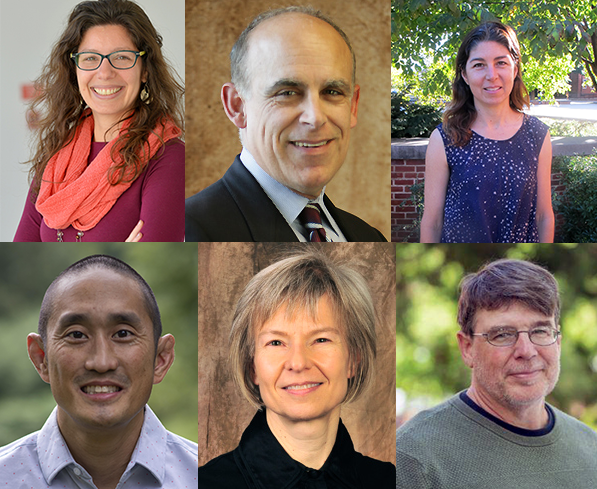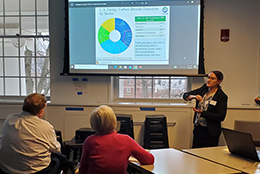 |

|
 |
From left: UMD Civil and Environmental Engineering Associate Chair for Undergraduate Programs Natasha Andrade; UMD Mechanical Engineering Professor David Bigio; College Park Scholars Assistant Director for Science, Technology, and Society Nicole Mogul; UMD Mechanical Engineering Senior Lecturer Vincent Nguyen; UMD Mechanical Engineering Professor Elisabeth Smela; and College Park Scholars Science, Technology, and Society Program Director David Tomblin. Andrade, Bigio, Nguyen, and Smela are leading the A. James Clark School of Engineering's Environmentally Socially Responsible Engineering (ESRE) initative, with support from the Lemelson Foundation, while Mogul and Tomblin helped organize and lead an ESRE workshop for faculty in 2023. |
|
Vibrations are a recurring phenomenon in nature and they also play an important role in human engineering, as UMD assistant professor Eleonora Tubaldi’s students learn when they study the subject. “Engineers traditionally think of vibrations as a problem, but they can also be harnessed for engineering purposes such as energy harvesting,” she explains.
Tubaldi and her students often look to nature, and to the behavior of biological organisms, for engineering inspiration. And they also engage the natural world in another way—by considering how engineering projects can be better integrated into the natural ecosystem, promoting sustainability. “The work we do doesn’t happen in isolation,’ she said. “We need to enlarge our perspective about what we do as engineers.”
It’s a theme increasingly heard among engineering faculty, reflecting awareness both of global challenges and of the profession’s capacity to help address them. But there’s a hitch: engineers don’t always know how best to successfully integrate environmental and social issues into the engineering classroom. To help bridge the gap, a team of UMD faculty has been working to provide opportunities for interested faculty, like Tubaldi, to share ideas, experiences, and recommendations.

UMD Associate Professor Katrina Groth discusses hydrogen fuel during an ESRE faculty workshop.
Four Clark School faculty members—Natasha Andrade (civil and environmental engineering), David Bigio (mechanical engineering), Vincent Nguyen (mechanical engineering), and Elisabeth Smela (mechanical engineering)—are spearheading the initiative, known as Environmentally Socially Responsible Engineering (ESRE). Their efforts are being supported by a grant from the Lemelson Foundation.
“The faculty are interested and willing, but they don’t necessarily know how, and they don’t typically have a background in these topics,” Smela said. “That’s where we come in. We can brainstorm ideas and provide training, allowing faculty members to integrate ESRE content into their courses.”
Andrade, who teaches an Engineering for Sustainability course in the civil engineering department, agrees that good intentions are often frustrated by the learning curve and lack of time. “Our goal is to lower the barrier,” she said.
A Workshop for Faculty
Last January, the ESRE team organized a workshop for faculty on the sustainability topics, drawing participants from across several departments at the A. James Clark School Engineering. They collaborated with experts specializing in the integration of engineering and social sciences, notably David Tomblin and Nicole Mogul of the Science, Technology, and Society (STS) program, and with DEI issues, notably Paige Smith of Women in Engineering and Rosemary Parker and Bongnwi Tangyie of the Center for Minorities in Science and Engineering, as well as with other faculty. Participants and supporters from Clark School leadership included Ken Kiger, Associate Dean for Undergraduate Programs, Kevin Calabro, Director of the Keystone Program, Bala Balachandran, Chair of Mechanical Engineering, and Pat McCluskey, Director of Undergraduate Studies in Mechanical Engineering.
Tomblin and Mogul have worked over the years to refine a “socio-technical”—as opposed to a narrowly technical – approach to engineering pedagogy. “Engineers are typically seen as problem-solvers, but a lot depends on how the problems are defined,” he said. “If you define a problem simply as ‘we need to build a bridge,’ for instance, you might end up with a bridge that doesn’t serve the needs of the community. That’s why it’s important to broaden the scope to encompass the societal context.”
The shift in perspective can help students in their future careers, Tomblin said. “Our students, when they go out into the world, will be working on the problem-definition part of the job as well as the solution aspect, and we want to equip them to be able to do this.”
As a follow-up to the workshop, the ESRE team now leads a Sustainability Community of Practice that provides regular opportunities for exchange of ideas and peer to peer mentoring.
The goals of the overall effort, as Smela explains, are ambitious. “We would ultimately like for every required undergraduate course to address environmental and social responsibility, so that students see it in different contexts each year.”
That can mean, as in Tubaldi’s class, studying bioinspired renewable energy solutions. Or it can mean, as in the Mechanical Engineering senior capstone design class, which in the past focused only on customers and engineering deliverables, incorporating a life-cycle assessment of the design and considering a wider set of stakeholders, from community members to local businesses.
An engineering ethics course taught by Mogul, meanwhile, is now a required course for all Clark School students.
From Technical to Socio-Technical
ESRE’s vision encompasses all three pillars of sustainability—environmental, economic, and societal—and thus also covers areas such as diversity, equity, and inclusion, all of which are seen as facets of the sustainability puzzle. Notes Mogul: “a synergy exists among ethics, DEI, and sustainability; they often need to be considered together.”
Socially responsible engineering, in this view, can also entail using engineering principles and techniques to assist people who face disabilities and other disadvantages.
Nguyen, for instance, has had students examine how vibrations can be harnessed in order to create an improved “swing therapy” device for a child with Down’s Syndrome. The class’s findings were incorporated into an actual product that was delivered to a family in the community.
Whether the scope is local or global, personal or planetary, young engineers often want to be change-makers, and incorporating environmental and socially responsible engineering into the curriculum can help them feel empowered to bring about such change, Smela said. That’s particularly important at a time when the weight of global challenges can often seem daunting and foster pessimism about humanity’s future, she added.
“Doomism is an impediment,” Smela said. “It’s important to remain cognizant of the fact that many changes for the better have been made over the past decades, and the status of human well-being on the planet has improved dramatically, in ways that people don’t always realize. The human lifespan has increased. There’s been a tremendous expansion in female literacy. Malaria rates are decreasing. Some rivers are getting cleaner. It’s important for engineering students to be aware of ‘good news’ data and to realize that they can play a part in bringing about further progress.”
Related Articles:
Investing in Environmentally Responsible Engineering
Sea Level Rise Could Leave Many Marooned
Grant Awarded for Study of Climate-Induced Septic Tank Failures
No Easy Way Home
Advancing Climate-Smart Construction
January 30, 2024
|

